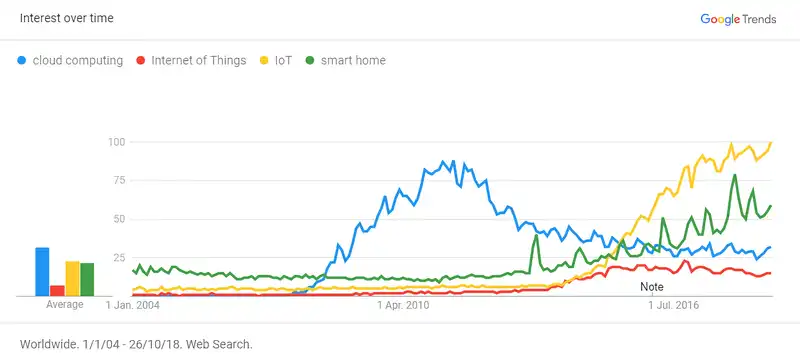Complicated or not, cloud migration is a necessity for all laggard organisations still using non-cloud applications. A necessity that’s apparently off the radar for many organisations according to data from Google Trends.

The future of cloud computing is straightforward
Spending on cloud computing is growing 6x faster than overall IT spending. According to Deloitte, spending on IT as a Service (data centres, infrastructure, software, and services) will reach $550B by the end of 2018, and cloud-based offerings will hold a 67% share of enterprise infrastructure and software by 2020.
The future of the cloud is an ever increasing range of services delivered with ever increasing scale. These services include Software as a Service (SaaS), Platform as a Service (PaaS), Infrastructure as a Service (IaaS), function as a service (FaaS), and even backend as a service (BaaS).

And these services enable, beyond simply generic umbrella terms such as cloud computing, whole new technological (and business) opportunities, such as the Internet of Things (IoT): smart homes, smart cities, smart cars, and more and of course, streaming services such as Netflix.

However you approach the cloud (software, platforms, infrastructure, etc.), it’s booming. The same can’t be said of cloud migration, which is surprising when you consider how many non-cloud, legacy applications are in active use.
The future of cloud migration is a mystery
The future of cloud migration is opaque, but the do’s and don’ts of cloud migration are clear. Watch now.
Microservices versus megaclouds
When an organisation’s software landscape is a highly fragmented collection of connected applications and services, this is called microservicing . (These applications and services can be custom software or off-the-shelf products managed by SaaS vendors.)
Microservicing involves shopping for small services specialised in solving specific problems and then integrating these services to create an ecosystem meeting all of your technology requirements.

The polar opposite of microservices are megaclouds . Think Salesforce, Workday, SAP, and Oracle. Megaclouds are the next generation of the enterprise software. They combine ERP, HR, CRM, and other features into monolithic one-stop shops.

The alluring promise of megaclouds is there’s no need to go through the hassle of stitching multiple vendor services or finding new services when organisational needs change. And maintaining data consistency and state of mind are simple because these megaclouds are capable of everything you need from your software.
As the number of microservices grows, so too does the range in services offered by megaclouds . There is no right answer to the question which is better: microservices versus megaclouds .
Owned versus licensed
In a world where there’s a cornucopia of microservices (3 new startups every second) and increasingly mega, megaclouds (AWS, Google, and Microsoft will capture 76% of all cloud platform revenue in 2018) there’s never been a better time to license your software requirements.
Paradoxically, there’s never been a better time to build custom software either. This is due to a combination of factors including the rise of low-code platforms and citizen developers and as well (in a second dose of paradox) the microservices and megaclouds mentioned earlier.
For many organisations there’s a much wider range of activities they engage in than there are core business processes and points of difference. The rise of highly interconnected cloud networks enables organisations to build custom software solutions for complex problems that they, as domain experts are perfectly positioned to solve while integrating with other platforms for the myriad of everyday task that still need doing.
For example, a biomedical company may build a proprietary platform for detecting a particular health condition, but integrate with MailChimp to keep in touch with its users and Atlassian’s Jira and Confluence to plan, track, manage, and document their internal software development projects.
Using secure API endpoints, a small and agile piece of custom software can integrate with one or more megaclouds/microservices to deliver (in many cases) the best of both worlds.
Methods more clear than outcomes
The rise of low-code platforms has reignited debate on rebuilding versus migrating applications.
The outcomes of cloud migration vary from initiative to initiative. In some cases, licensed microservices are preferable, whereas in others owned megaclouds are. The bases processes involved in migrating are largely uniform despite these variables.
The future of cloud migration is one where these processes are becoming faster, simpler, and more automated, focusing on continuous modernisation. Codebots, for example, can transform an Access database into a fully, functioning web application backend with developer API protocols in a matter of minutes.





